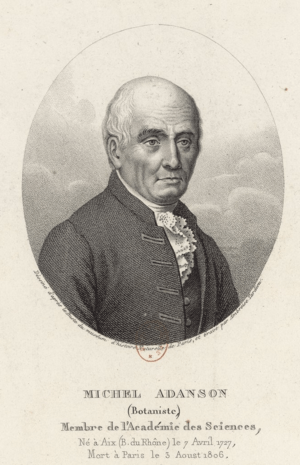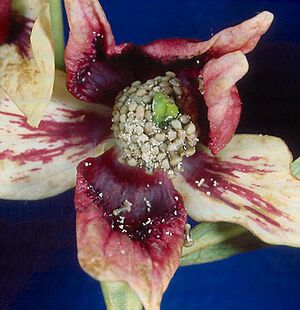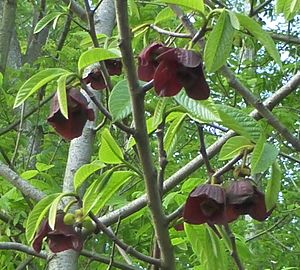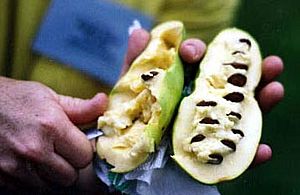Asimina facts for kids
Quick facts for kids Pawpaw |
|
|---|---|
 |
|
| Asimina triloba (common pawpaw) in fruit |
|
| Scientific classification |
|
| Genus: | Magnoliophyta |
| Genus: | Magnoliopsida |
| Genus: | Magnoliales |
| Genus: | Annonaceae |
| Subfamily: | Annonoideae |
| Genus: | Asimina Adans. |
| Type species | |
| Asimina triloba |
|
| Synonyms | |
|
|
Asimina is a group of small trees or shrubs. Scientists first described this group in 1763.
Pawpaws have large simple leaves and big fruits. They grow naturally in eastern North America. The most common type is the Asimina triloba, also known as the common pawpaw. This tree produces the largest edible fruit that grows naturally in the United States. Pawpaws are found in 26 states in the U.S. and in Ontario, Canada. The common pawpaw often grows in groups, forming thick patches. It likes well-drained, rich soil in lowlands and hills. Pawpaws belong to the same plant family (Annonaceae) as fruits like the custard-apple, cherimoya, sweetsop, and soursop. This group of plants is special because it's the only one in its family that isn't found only in tropical areas.
Contents
Names
The name Asimina was first given by Michel Adanson. He was a French naturalist with Scottish roots. The name comes from the Native American word assimin. The French colonists then changed it to asiminier.
The common name (American) pawpaw is also spelled paw paw or papaw. It probably comes from the Spanish word papaya. This is because the fruits look a bit similar on the outside.
Description
Pawpaws can be shrubs or small trees. They usually grow from 2 to 12 meters (about 6 to 39 feet) tall. The common pawpaw (Asimina triloba) grows in colder northern areas. It is deciduous, meaning it loses its leaves in the fall. Other pawpaw types that grow in the south often stay evergreen, keeping their leaves all year.
The leaves grow alternately along the stem. They are oval-shaped, smooth, and usually 20 to 35 centimeters (8 to 14 inches) long. They are also 10 to 15 centimeters (4 to 6 inches) wide.
Pawpaw flowers grow either alone or in groups of up to eight. They are large, about 4 to 6 centimeters (1.5 to 2.5 inches) across. Each flower has six sepals (leaf-like parts) and six petals. There are three large outer petals and three smaller inner petals. The petals can be white, purple, or reddish-brown.
The fruit of the common pawpaw is a large, edible berry. It is 5 to 16 centimeters (2 to 6 inches) long and 3 to 7 centimeters (1 to 3 inches) wide. Each fruit can weigh from 20 to 500 grams (0.7 to 17.6 ounces). It has many seeds inside. When unripe, the fruit is green. It turns yellow or brown as it ripens. The taste is a bit like a mix of banana and mango. The flavor can be quite different depending on the specific type of pawpaw. Pawpaw fruit also has more protein than most other fruits.
Species and their distributions
There are several accepted species of pawpaw. Here are some of them:
- Asimina angustifolia: Found in Florida, Georgia, Alabama, and South Carolina.
- Asimina incana (Woolly pawpaw): Grows in Florida and Georgia.
- Asimina longifolia (Slimleaf pawpaw): Found in Florida, Georgia, and Alabama.
- Asimina pulchella (White Squirrel Banana): Only found in three counties in Florida. This species is endangered.
- Asimina rugelii (Yellow Squirrel Banana): Only found in Volusia county, Florida. This species is also endangered.
- Asimina obovata (Flag-pawpaw or Bigflower pawpaw): Grows in Florida.
- Asimina parviflora (Smallflower pawpaw): Found in southern states from Texas to Virginia.
- Asimina pygmaea (Dwarf pawpaw): Grows in Florida and Georgia.
- Asimina reticulata (Netted pawpaw): Found in Florida and Georgia.
- Asimina tetramera (Fourpetal pawpaw): Grows in Florida and is endangered.
- Asimina triloba (Common pawpaw): This is the most widespread type. It grows in southern Ontario, Canada, and across the eastern United States. Its range goes from New York west to southeast Nebraska, and south to northern Florida and eastern Texas.
Ecology
The common pawpaw naturally grows in shady, rich lowlands. It often forms a thick undergrowth in forests. You might see it as a patch or thicket of many small, thin trees.
Pawpaw flowers are pollinated by insects. However, not many fruits are produced because the flowers have a very faint or no scent. The flowers produce an odor like rotting meat. This smell attracts blowflies or carrion beetles. These insects help move pollen from one flower to another. Other insects like scavenging fruit flies, carrion flies, and beetles are also attracted to pawpaw plants. It is thought that pawpaw flowers might not be able to pollinate themselves.
Pawpaw fruit can be eaten by animals like foxes, opossums, squirrels, and raccoons. However, rabbits or deer rarely eat pawpaw leaves and twigs.
The leaves, twigs, and bark of the common pawpaw tree contain natural insect-killing chemicals. These are called acetogenins.
The larvae (young caterpillars) of the zebra swallowtail butterfly only eat the young leaves of pawpaw species. But you won't find many of these butterflies on the plants.
Some scientists believe the pawpaw is an "evolutionary anachronism." This means that long ago, large animals, like those from the Ice Age, might have eaten the fruit. These animals would have helped spread the seeds.
Cultivation and uses
People in eastern North America have enjoyed wild common pawpaw (Asimina triloba) fruits for a long time. Fresh pawpaw fruits are usually eaten raw. However, they don't store or ship well unless they are frozen. The fruit pulp is also used in baked desserts. Pawpaw can often be used in recipes that call for bananas.
Pawpaws have not been grown on the same large scale as apples or peaches. But in recent years, more people have become interested in growing them. Only frozen fruit can be stored or shipped well. Other ways to preserve pawpaws include dehydration (drying), making jams or jellies, and pressure canning.
Pawpaws are also becoming popular with backyard gardeners. People like their unique way of growing, their fresh fruit, and how easy they are to care for once they are established. The common pawpaw is also useful in ecological restoration projects. This is because it grows well in wet soil and tends to form strong, rooted thickets.
The other types of Asimina pawpaws are not used much for economic purposes.
History
The first time pawpaws were written about was in 1541. This was in a report from the Spanish de Soto expedition. They saw Native Americans growing pawpaws east of the Mississippi River. Chilled pawpaw fruit was a favorite dessert of George Washington. Thomas Jefferson even planted pawpaw trees at his home in Virginia, Monticello. The Lewis and Clark Expedition sometimes ate pawpaws to survive during their travels. Daniel Boone also enjoyed pawpaws. In 2009, the common pawpaw was named the native fruit of Ohio.
See also
 In Spanish: Asimina para niños
In Spanish: Asimina para niños





